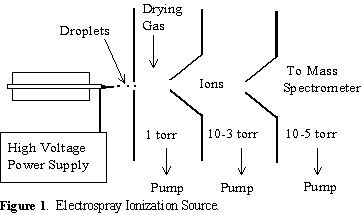
API sources introduce the sample through a series of differentially pumped stages. This maintains the large pressure difference between the ion source and the mass spectrometer (Figure 7) without using extremely large vacuum pumps. In addition a drying gas is used to break up the clusters that form as the solvent evaporates. Because the analyte molecules have more momentum than the solvent and air molecules, they travel through the pumping stages to the mass analyzer.

ElectroSpray Ionization (ESI) is the most common API application. It has undergone remarkable growth in recent years and is frequently used for LC/MS of thermally labile and high molecular weight compounds. The electrospray is created by applying a large potential between the metal inlet needle and the first skimmer in an API source (Figure 7). The mechanism for the ionization process is not well understood and there are several different theories that explain this ionization process. One theory is that as the liquid leaves the nozzle, the electric field induces a net charge on the small droplets. As the solvent evaporates, the droplet shrinks and the charge density at the surface of the droplet increases. The droplet finally reaches a point where the coulombic repulsion from this electric charge is greater than the surface tension holding it together. This causes the droplet to explode and produce multiply charged analyte ions. A typical ESI spectrum shows a distribution of molecular ions with different charge numbers.
Because electrospray produces multiply charged ions, high molecular weight compounds are observed at lower m/z value. This increases the mass range of the analyzer so that higher molecular weight compounds may be analyzed with a less expensive mass spectrometer. An ion with a mass of 5000 u and a charge of +10 is observed at m/z 500 and is easily analyzed with an inexpensive quadrupole analyzer.
API Sources are also used for Inductively Coupled Plasma Mass Spectrometry (ICP/MS) and glow discharge experiments ((4), (5), (6)). In ICP/MS a nebulizer is used to introduce liquid samples into a high temperature plasma. The temperature of the plasma is high enough to efficiently ionize most elements. These ions are introduced to the mass spectrometer using an series of differentially pumped regions similar to the electrospray source discussed above. Glow discharge experiments are similar, but used for solid samples. The high sensitivity and selectivity of the mass spectrometer provides rapid multielement detection at very low levels. Because the high temperature of the plasma destroys any chemical bonds, these techniques are used for elemental analysis.
1. Huang, E.C.; Wachs, T.; Conboy, J.J.; Henion, J.D. Anal. Chem. 1990, 62, 713A-725A.
2. Smith, R.D.; Wahl. J.H.; Goodlett, D.R.; Hofstadler, S.A. Anal. Chem. 1993, 65 574A-584A.
3. Hofstadler, S.; Bakhtiar, R.; Smith, R. J. Chem. Educ. 1996, 73, A82-A88.
4. Harrison, W.W.; Hess, K.R.; Marcus, R.K.; King, F.L. Anal. Chem. 1986, 58, 341A-356A.
5. Houk, R.S. Anal. Chem. 1986, 58, 97A-105A.
6. Vela, N.P.; Olson, L.K.; Caruso, J.A. Anal. Chem. 1993, 65, 585A-597A.